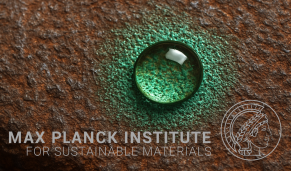Sustainable Steel: Role of Interfaces in Hydrogen-Based Direct Reduction
Complex Interfaces and Interface Complexions in Hydrogen-Based Iron Reduction and Green Steelmaking
In the production and utilization of iron oxides, we recognize and describe in our recent paper (Nature Communications 16 (2025) 2705) that interfaces in green metal production must be regarded as Thermodynamic Defect Phases.
In general, interfaces govern nearly all key phenomena—from corrosion and catalysis to hydrogen-based direct reduction (HyDR). Traditional bulk phase diagrams describe equilibrium among defect-free solids, whereas crystal imperfections are usually treated as kinetic artifacts. We adopt the defect-phase or complexion concept to unify these views: interfacial regions can represent distinct thermodynamic phases that exist only in the presence of adjoining lattices.
At the Fe/Fe₃O₄ boundary—central to the wüstite–magnetite–metal sequence that dominates HyDR—we have observed, using differential-phase-contrast four-dimensional scanning-transmission electron microscopy (DPC-4D-STEM), a two-atomic-layer FeO-like phase that we identify as an interfacial complexion. Our density-functional-theory (DFT) calculations show that this complexion maximizes adhesion (≈ –3.9 J m⁻² compared to –2.7 J m⁻² for a clean interface) and stabilizes within an oxygen-chemical-potential window of ΔμO ≈ –1.7 to –1.9 eV at 300 °C—corresponding to O₂ partial pressures between roughly 10⁻¹⁶ and 10⁻¹⁹ mbar. These values coincide with the oxygen activities typically encountered in hydrogen-rich or plasma-assisted iron-reduction environments.
Complexions at the iron-magnetite interf[...]
PDF-Dokument [3.1 MB]
Atomic-Scale Origin of Interface Complexions at the Fe/Fe₃O₄ interface
We find that the Fe/Fe₃O₄ interface is not an abrupt geometric plane but reconstructs into a well-ordered, wüstite-type FeO bilayer. DPC-4D-STEM allows us to image both Fe and O atomic columns simultaneously. We detect that Fe atoms at tetrahedral sites within the magnetite lattice shift toward the metallic Fe by several picometers, while O columns relax slightly toward the oxide side—evidence of local stoichiometric re-equilibration at the boundary.
With decreasing oxygen potential—that is, under increasingly reducing conditions—thicker FeO complexions collapse to a bilayer and eventually vanish. Under higher oxygen activities, extended wüstite films become stable. This thermodynamic continuity among defect-phase states parallels classical bulk phase transitions and permits construction of complexion diagrams parameterized by μO and temperature, analogous to bulk phase diagrams but specific to interfaces.
Functional Consequences for Redox Kinetics in Green Steel Making via Hydrogen-Based Direct Reduction
We observe that the FeO complexion fundamentally changes interfacial transport. Charge-density-difference maps (Fig. 2) reveal enhanced electron localization at the Fe/FeO boundary and an increase in the work of adhesion by about 20 %. The FeO layers act as efficient sinks for Fe vacancies and as charge-transfer bridges, thereby controlling point-defect and electron fluxes during redox cycles.
During hydrogen-based reduction—where Fe₃O₄ → FeO → Fe proceeds through coupled Fe-vacancy diffusion and O²⁻ removal—these complexions define the kinetic bottlenecks. Depending on their structure, they can either hinder or catalyze the transformation by modifying anion diffusivity and hydrogen dissociation. Both DFT and in-situ microscopy confirm that such FeO interfacial phases persist metastably at ≈ 300 °C, well below the 570 °C bulk stability threshold of wüstite. We therefore conclude that the interface itself can shift phase equilibria by several hundred kelvin—demonstrating the decisive thermodynamic role of interfacial confinement.
Implications for Sustainable Metallurgy
Within industrial HyDR and hydrogen-plasma smelting-reduction (HPSR) processes, the Fe–Fe₃O₄–FeO triple junction controls overall reduction kinetics and impurity transport. By treating the FeO-like complexion as an equilibrium defect phase, we can predict and tune:
- Mass-transport rates. Vacancy and electron conductivities within the FeO complexion dominate the Fe²⁺/Fe³⁺ redox exchange and determine the rate of oxygen removal.
- Interfacial adhesion. The strong Fe/FeO bonding (γ ≈ –3.9 J m⁻²) enhances the mechanical stability of the growing metallic shell, suppressing spallation during HyDR pellet reduction.
- Catalytic behavior. Local charge redistribution at the FeO complexion alters the kinetics of hydrogen dissociation and H₂O recombination, thereby improving hydrogen utilization efficiency.
- Thermodynamic stability. Complexion diagrams provide quantitative stability fields for interfacial phases under defined μO–T conditions, guiding atmosphere control in both shaft-furnace and plasma reactors.
Through this perspective, we regard interfaces not as passive geometrical boundaries but as tunable reaction media. By deliberately designing interfacial complexions—through temperature, gas composition, or dopant segregation—we can control redox kinetics, minimize energy losses, and stabilize metastable pathways that foster dense, conductive metallic networks during hydrogen reduction.
In summary we can state that by integrating atomic-scale thermodynamics with macroscopic reaction engineering, we establish a direct connection between the interfacial structure of Fe–oxide boundaries and the performance of green-steel processes. We foresee that complexion-aware process design will enable predictive control of reduction kinetics and alloy microstructures. Combining DPC-4D-STEM, DFT, and operando spectroscopy will allow us to map complexion transformations in real time during reduction or oxidation. Ultimately, such data can feed AI-guided models that design microstructures in which interfacial complexions—once considered imperfections—become functional catalysts for a fully decarbonized metallurgical industry.
The Fate of Water in Hydrogen-Based Iron[...]
PDF-Dokument [2.6 MB]

![a Experimental (Exp.) differential phase contrast (DPC) - four-dimensional scanning transmission electron microscopy (4DSTEM) reconstruction for Fe3O4[110]: i Reconstructed virtual dark-field image ii Electric field vector map iii Projected electrostatic](https://www.dierk-raabe.com/s/cc_images/cache_2498074551.png?t=1761408050)

